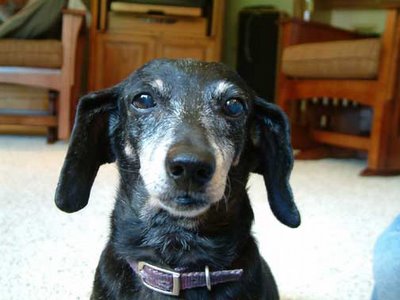Good-Bye To a Family Friend
by Steve Sorensen
(Originally published in the Warren Times Observer, Warren, PA., December 24, 2005.)
Our 14-year-old miniature dachshund wasn't a sporting dog, but she had the heart of a hunter.Her whip-tail controlled every inch of dog except her
intelligent, probing nose, which was all business as it
sniffed the wild and exhilarating smells that accumulated
on my pant legs from my hours in the woods.
Greta's ancestors were bred in Germany to hunt dachs, a European badger. Here in the northeast United States, groundhogs occupy the niche that satisfied her need for the chase. From puppyhood, she would pursue groundhogs down their holes -- just because she needed to.
We'd worry sometimes when she was inside a groundhog's den, yapping herself hoarse, that she might not get out -- that a groundhog every bit as big as her might get the best of her. But the size of the fight in her was bigger than any groundhog -- or anything else she encountered. That's what she was bred for, and the fight in her lasted until the end.
Greta was a tough old girl even when she was young, and she stared death down several times. In the springtime she loved to run in tall weeds -- all weeds were tall to her -- and she would come home with wicked looking allergic rashes where the weeds whipped and scarred her little barrel chest. One time she swallowed a honeybee, which stung her internally and she went into shock. She barely survived in time to reach the vet's office.
She wasn't aware that she was a pipsqueak in dog-dom. Apparently other dogs didn't look very big to her from a distance, and she would race out to intimidate any that dared stroll by. One day a big dog wouldn't stand down. It fought back, and ripped her abdomen open. Another trip to the vet, this time for surgery.
When she finally realized that few dogs were her enemies, her playful side emerged often. Her rambunctious wrestling twice resulted in cauliflower ear, which required the veterinarian's surgical attention again.
Whenever I came home from hunting, even a couple of days before her death, she would dance and prance like a puppy. Her whip-tail controlled every inch of dog except her intelligent, probing nose, which was all business as it sniffed the wild and exhilarating smells that accumulated on my pant legs from my hours in the woods.
Whenever I brought a deer home, she stood guard while I skinned the deer in the garage. Usually my neighbor-brother would bring his 2 dachshunds over for a look-see, and Greta would position herself between them and the deer. When she heard another dog bark -- even if it was so far away that it was barely audible -- she would growl a warning as if to say, "Keep away from our deer."
For the last couple of years cataracts clouded her vision, but the more serious malady was congestive heart failure. Fluid in her lungs relentlessly punished her strong will to be a dog. Growling at imagined threats and barking at woodchucks diminished, and coughing became her trademark. She was tough enough to survive other close calls, but this one would eventually take her.
On the Saturday after Thanksgiving her breathing became very shallow, and she sat up all night. She couldn't lie down because the pressure of her 10-pound body on her chest made it even more difficult to breathe. We came home from church on Sunday and found her exhausted, but stubbornly sitting up. I took her outside for potty time. After obediently doing her final duty she was too weak to stand. Her hips rolled over and she staggered. Before her front legs toppled, I picked her up and brought her inside.
She rested her head against my chest and stopped breathing. I gently placed my hand on her chest until I felt her valiant heart finally quit. I dug a hole in the back yard. It was hard to put her in it.
Greta wasn't the smartest dog around, but she was the favorite even of many other dog owners -- full of character and personality -- or at least "canine-ality". She was as loyal as any dog can be. She would love you whether you did right or wrong, whether you punished her or praised her, whether you ignored her or indulged her.
Other families are equally blessed by hunting dogs, lap dogs, service dogs, show dogs -- dogs that love without condition, serve without reservation, and offer joy without hesitation. Greta wasn't unique, but she was one of a kind. She was our dog.
Greta, we saw you through so many hazards. We're sorry we couldn't get you through this one.



